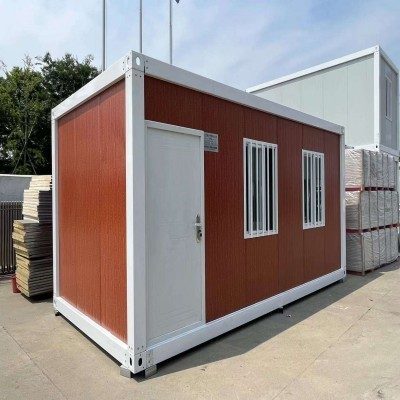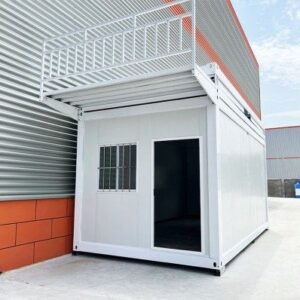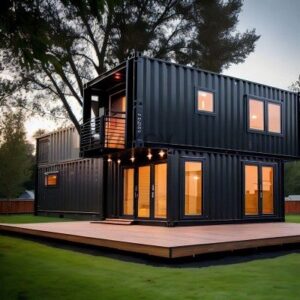If you’re wondering how to build a house from shipping containers, you’re in the right place. Container homes are transforming modern living—offering affordable, sustainable, and surprisingly stylish alternatives to traditional builds. But before you jump in, there’s a lot to consider: from planning and design to construction techniques and cost.
In this guide, you’ll get a straightforward, step-by-step roadmap that breaks down everything you need to know to turn steel boxes into a comfortable, efficient home. Whether you’re a DIY enthusiast, a builder, or just curious about sustainable housing, this is your go-to resource for making container living a reality. Let’s get started!
Shipping Container Homes What is a Shipping Container House
A shipping container house is a residential structure made from repurposed steel shipping containers. These containers, typically used for freight transport, are modified and transformed into functional living spaces. Building a house from shipping containers offers a unique blend of durability, affordability, and eco-friendliness. With the rising interest in modular shipping container homes, many people are exploring this innovative construction approach as an alternative to traditional building methods.
Advantages and Challenges of Building with Containers
Using shipping containers as building blocks for homes comes with several advantages:
- Durability: Made from weather-resistant steel, shipping containers are strong and built to withstand harsh conditions.
- Affordability: Container homes can be less expensive compared to traditional houses, especially when factoring in construction time.
- Speed of Construction: Containers provide a pre-made structure, speeding up the building process.
- Sustainability: Reusing shipping containers reduces waste and supports eco-friendly living.
- Modularity: Containers can be stacked or arranged in various configurations, allowing flexible design options.
However, there are also challenges to consider:
- Insulation and Condensation: Steel containers conduct heat and cold, requiring effective insulation to maintain comfort.
- Structural Modifications: Cutting openings for windows and doors weakens container strength, so reinforcements are necessary.
- Regulations: Local building codes and zoning laws may limit or complicate container home construction.
- Space Constraints: Standard container dimensions can limit interior layouts, demanding creative design solutions.
Types and Sizes of Shipping Containers Suitable for Homes
Shipping containers come mainly in two standard sizes ideal for homes:
| Container Type | Dimensions (L x W x H) | Notes |
|---|---|---|
| 20-foot Container | 20 ft x 8 ft x 8.5 ft | Compact, great for tiny homes or studios |
| 40-foot Container | 40 ft x 8 ft x 8.5 ft | Provides more space, suitable for larger homes or multi-room layouts |
Additionally, high cube containers offer an extra foot of height (9.5 ft) for more headroom. Both new and used containers are used in construction, with new containers offering better structural integrity but at a higher cost.
Planning Your Shipping Container Home
When you’re ready to build a shipping container home, planning is crucial to stay on budget and meet legal requirements. Here’s what you need to focus on to get started right.
Assess Your Budget and Financing Options
Building a house from shipping containers can be affordable, but costs add up quickly. Before designing your container home, get a solid budget in place. Consider:
- Container costs: New containers cost more but require less repair; used containers are cheaper but may need more work.
- Site work and foundation: Depending on your location, foundation types can vary in cost.
- Modifications and finishes: Cutting, insulation, plumbing, and electrical add to expenses.
- Permits and professional fees: Remember costs for architects, engineers, and permits.
For financing, options include:
- Traditional mortgages (may be more difficult to get)
- Construction loans
- Personal loans or savings
- Specialized lenders experienced with modular or alternative homes
Understand Local Building Regulations and Permits
Not all locations treat container homes the same. Check your local building codes, zoning laws, and permit requirements early on. Important points:
- Some areas have restrictions on modular or unconventional homes.
- Permits for electrical, plumbing, and structural changes are usually required.
- Site-specific rules may affect foundation types and setbacks.
Contact your local building department or a professional familiar with container homes in your area to avoid surprises.
Design Floor Plans and Layout for Shipping Container Homes
Shipping container homes require smart space planning. Standard containers are narrow (usually 8 feet wide), so designs need to maximize usable space and flow. Keep these tips in mind:
- Open floor plans reduce the cramped feeling.
- Plan insulation and ventilation carefully.
- Think about natural light by adding windows and doors strategically.
- Consider multi-level stacking for more space without expanding footprints.
Choosing Single Container Versus Multi-Container Assemblies
Your choice between a single container home and multi-container assemblies will affect design, cost, and complexity:
- Single container homes: Easier and quicker to build, lower cost, but limited space.
- Multi-container homes: More flexible layouts and room for customization, but require expert welding, reinforcing, and increased foundation work.
Decide based on your space needs, budget, and desired style. Many successful homes combine containers in L-shapes, stacks, or side-by-side layouts for more room and design variety.
Planning with these steps ensures your shipping container home fits your goals and stays within regulations and budget. Take your time here—this is the foundation of a smooth build.
Preparing Shipping Containers for Your Container Home
Sourcing Quality Shipping Containers Used vs New
One of the first steps in building a shipping container house is choosing the right containers. You can either go with new or used containers, each having pros and cons:
- New Containers
- Come with no rust, dents, or wear
- Often more expensive
- Require less immediate repair and maintenance
- Used Containers
- More affordable, often 30-50% less than new
- May have minor dents, rust spots, or previous modifications
- Need thorough inspection for structural damage or hazardous materials (avoid “one-trip” containers used for chemicals)
Be sure to inspect for structural integrity and confirm containers meet your local building codes, especially for home use.
Structural Modifications Cutting Reinforcing and Insulation Needs
Shipping containers are steel boxes that need careful modification to transform them into livable spaces:
- Cutting Openings
- You’ll need to cut spaces for doors, windows, and vents
- Removing sections weakens the structure; steel reinforcements or welding around modified areas is essential
- Plan cuts carefully to avoid compromising the container’s strength
- Reinforcing Containers
- Reinforcements may include adding steel frames or cross-bracing
- Structural engineering consults help ensure safety, especially for multi-container assemblies or stacking
- Insulation Needs
- Steel containers conduct heat and cold rapidly, so insulation is a must
- Options include spray foam, rigid foam panels, or blanket insulation
- Proper insulation tackles condensation issues and keeps your home energy-efficient and comfortable
Tools and Safety Equipment Required for Container Modifications
Working with shipping containers requires specific tools and safety gear to handle steel construction and heavy materials:
- Essential Tools
- Plasma or oxy-acetylene cutter for precise metal cutting
- Welding machine for joining and reinforcing steel
- Angle grinder, drill, and metal files for finishing edges
- Measuring tape, level, and chalk line for accurate markings
- Safety Equipment
- Heavy-duty welding gloves and protective sleeves
- Welding helmet with proper shade
- Safety glasses or goggles
- Respirators or masks to protect from dust and fumes
- Steel-toed boots and hard hat to protect feet and head during heavy work
Taking safety seriously is key, especially since steel cutting and welding can be hazardous without proper precautions.
Step by Step Construction Process for Building a Shipping Container Home
Building a shipping container home involves several key steps that ensure your container house is sturdy, comfortable, and meets building standards. Here’s a straightforward breakdown of the process to help you understand what’s involved.
Site Preparation and Foundation Installation
Before your containers arrive, prepare the site carefully:
- Clear and level the land for a stable base.
- Select a foundation type suitable for container homes such as concrete slab, pier foundations, or steel piles. This ensures proper support and prevents shifting.
- Make sure drainage and soil conditions are considered to avoid moisture issues.
A good foundation is critical because containers are heavy and need a flat, solid base.
Container Delivery and Placement
Once the foundation is ready:
- Arrange for shipping container delivery on site, checking the condition of each unit.
- Use cranes or forklifts to place the containers in the correct orientation according to your planned design.
- Ensure containers are precisely aligned to simplify joining and finishing work.
Joining Multiple Containers Securely
If you’re working with more than one container:
- Cut and weld containers together at connection points to form a strong, unified structure.
- Reinforce joints as needed, especially emphasizing load-bearing areas.
- Seal seams to prevent water penetration and improve insulation effectiveness.
Proper connection improves the home’s structural integrity and helps meet local building codes for container homes.

Insulating and Weatherproofing Container Walls and Roofs
Containers are made of steel, which easily gains and loses heat, so insulation is a must:
- Choose insulation methods such as spray foam, rigid foam panels, or blanket insulation designed for metal siding.
- Add weatherproof barriers and vapor retarders to control condensation and protect interior walls.
- Apply exterior cladding or roofing materials to extend durability and improve energy efficiency.
Good insulation keeps your container home comfortable year-round while reducing energy costs.
Installing Doors, Windows, Electrical Wiring, and Plumbing
Next, cut openings for doors and windows carefully to maintain structural strength:
- Use proper framing around openings to support the metal structure.
- Install energy-efficient windows and exterior doors designed for container homes.
- Plan and complete electrical wiring and plumbing following local building regulations.
- Work with certified electricians and plumbers to ensure safety and compliance.
This step transforms the container from a shell to a livable space.
Interior Finishing Flooring Walls and Cabinetry
The final step is the interior:
- Add subflooring and your choice of flooring like hardwood, tile, or laminate.
- Frame and finish walls with drywall or other materials to cover insulation.
- Install cabinetry, shelving, and fixtures based on your design preferences.
- Pay attention to ventilation and lighting to enhance comfort inside your container home.
This is where your home gains personality and functionality.
By following these container home construction steps carefully, you can build a durable, comfortable, and stylish shipping container house ready for everyday living.
Cost Breakdown and Budget Tips for Building a Shipping Container Home
When figuring out the cost to build a container home, you’ll want to understand typical price ranges and what drives those costs. On average, building a shipping container house in the U.S. can range from $150 to $300 per square foot. This depends heavily on factors like container quality, site conditions, design complexity, and local labor costs.
Typical Cost Ranges and What Impacts Price
- Shipping container price: New containers can cost between $3,000 and $5,000 each, while used containers might be $1,500 to $3,000, depending on condition.
- Site preparation and foundation: This can cost $5,000–$15,000 depending on terrain and foundation type (slab, pier, or crawl space).
- Modifications: Cutting for windows, doors, and reinforcement can add $10,000 or more.
- Insulation and weatherproofing: Expect $5,000–$15,000 depending on method (spray foam, rigid board, or blanket insulation).
- Interior finishes: Flooring, walls, cabinetry, plumbing, and electrical work often push the budget higher, typically $20,000–$50,000.
- Permits and inspections: These can vary widely by location but set aside at least $1,000–$5,000.
How to Save Money Without Compromising Safety or Quality
- Buy used shipping containers in good condition—avoid ones with severe rust or structural damage.
- Simplify your design by using fewer containers or avoiding complicated rooflines and layouts.
- Handle some work yourself like painting, flooring, or cabinetry installation if you have the skills.
- Opt for standard-sized containers to avoid costly custom modifications.
- Plan utilities carefully so plumbing and electrical runs are straightforward and efficient.
- Use energy-efficient materials from the start to reduce utility costs long-term.
Hidden Expenses to Watch Out For
- Delivery and crane costs: Moving and placing heavy containers isn’t cheap and often adds several thousand dollars.
- Unexpected repairs: Containers might need rust treatment, dents fixed, or extra reinforcements once you open them up.
- Upgrading insulation: Poor insulation will cost more energy later, so don’t skimp here.
- Permit delays or code compliance: Local building departments may require costly upgrades to meet safety codes.
- Utility hookups: Water, sewer, and electrical connections can add up quickly, especially in remote areas.
Understanding these cost factors and planning ahead can help you build your shipping container home efficiently without surprises. Always balance savings with quality to ensure your container home is durable and comfortable for years to come.
Sustainability and Energy Efficiency in Shipping Container Homes
Shipping container homes naturally appeal to green building enthusiasts because they reuse steel containers destined for scrap, cutting down on new building materials and waste. Beyond that, their modular design allows for efficient construction with minimal site disruption, which is a big plus for eco-conscious homebuyers.
Green Benefits of Container Home Construction
- Reduced Carbon Footprint: Reusing containers lowers demand for traditional building materials like concrete and lumber, which have higher environmental impacts.
- Less Construction Waste: Fewer off-cuts and waste materials compared to conventional builds.
- Compact, Efficient Spaces: Smaller footprints mean lower energy use for heating, cooling, and lighting.
Energy Saving Features to Consider
- Solar Power Systems: Installing solar panels is a popular way to power container homes sustainably, significantly cutting electricity costs.
- Rainwater Harvesting: Rainwater collection systems can be integrated easily to reduce reliance on city water for irrigation and non potable uses.
- Energy Efficient Appliances: Using ENERGY STAR appliances and LED lighting further trims energy consumption.
How Yichen Incorporates Eco Friendly Principles
Yichen focuses on making container homes both sustainable and energy efficient through several targeted strategies:
| Eco Feature | Description |
|---|---|
| High-Quality Insulation | Advanced insulation solutions reduce heating/cooling loads. See how to insulate container house for energy savings |
| Energy Efficient Windows | Double-glazed windows minimize heat transfer to control indoor climate. |
| Solar Panel Ready Designs | Containers are prepped for easy solar panel installation to harness renewable energy. |
| Rainwater Recycling Options | Designs include features for integrated rainwater collection and filtration systems. |
| Sustainable Finishing Materials | Use of non-toxic, recycled, or low-impact materials in cabinetry, flooring, and paint. |
These eco-friendly details not only reduce utility bills and environmental impact but also enhance the comfort of living in a container home.
To explore more about sustainable container homes and options tailored for energy efficiency, visit Yichen’s flat pack container house and other models designed for green living.
Common Challenges in Building Shipping Container Homes and How to Overcome Them
Building a shipping container home comes with unique challenges. Knowing these issues upfront helps you plan better and avoid costly mistakes.
Dealing with Insulation and Condensation Issues
Insulation is critical for a container home because steel container walls easily absorb heat and cold. Without proper insulation, you’ll face uncomfortable temperatures and condensation problems.
- Condensation control: Container walls often trap moisture, leading to rust and mold. Use vapor barriers combined with effective insulation materials like spray foam or rigid panels to reduce this risk.
- Choose insulation wisely: Spray foam offers great coverage and moisture resistance but is pricier. Rigid foam boards or mineral wool are budget-friendly options but need careful sealing.
- Ventilation: Proper airflow is essential to keep moisture at bay. Installing vents and mechanical ventilation systems can help manage humidity inside the home.
Structural Integrity Concerns and Solutions
Shipping containers are strong, built to withstand heavy loads at sea, but turning them into homes means cutting into their structure for doors, windows, and connecting multiple containers.
- Reinforce cut areas: Any wall or roof modification requires reinforcement, usually with steel beams or welded supports, to maintain structural stability.
- Foundation matters: Proper foundations such as concrete piers or slab foundations keep the containers level and reduce movement, which is vital for long-term durability.
- Quality container selection: Starting with containers in good condition minimizes structural repairs. Inspect for rust, dents, or previous damage.
Legal and Regulatory Hurdles
Local building codes and zoning laws can affect your container home project significantly. These regulations vary widely by state and municipality.
- Permits: Always check with your city or county about permits needed for container homes. Failing to get the right permits can cause delays or fines.
- Building codes: Some areas may have strict rules on container homes, such as minimum insulation standards, foundation types, or design restrictions.
- Work with experienced professionals: Hiring architects or builders familiar with modular shipping container homes can smooth the approval process and ensure your design complies with regulations.
Knowing these challenges and how to address them early will save time and money, ensuring your container home is safe, comfortable, and legal.
For detailed info on costs and regulations, check out how much to build a shipping container house and shipping container house building regulations.
Inspiration and Real Life Examples of Shipping Container Homes
Seeing successful shipping container homes is one of the best ways to get inspired and understand what’s possible. Many people in the U.S. have embraced container living, proving these homes can be stylish, comfortable, and energy-efficient.
Showcase of Successful Shipping Container Homes
Across the country, you’ll find many standout projects:
- Modern urban lofts using multi-container assemblies that maximize space and natural light
- Compact weekend cabins built from a single container, perfect for affordable retreats
- Family homes with creative layouts, including rooftop decks and open floor plans
- Off-grid properties equipped with solar panels and rainwater harvesting for sustainable living
These examples show that whether minimalist or luxurious, container homes suit various lifestyles and budgets.
Creative Design Ideas to Personalize Your Shipping Container Home
To make your container house truly yours, consider:
- Mixing materials like wood siding or glass walls to soften the industrial look
- Using color boldly – bright paint and artistic murals can give each container distinct character
- Adding outdoor spaces such as patios or green roofs to extend living areas
- Custom interior layouts focusing on open-plan living, built-in furniture, and maximizing storage
- Integrating smart home tech for convenience and energy efficiency
Personal touches like these help align your container home with your taste and needs.
Testimonials and Case Studies from Yichen Customers
At Yichen, we’ve seen firsthand how customers transform containers into warm, livable homes:
- One family in Texas shared how modular shipping container homes helped save thousands while providing a durable, weather-resistant structure.
- A couple in California praised our design support, highlighting how the custom floor plans adapted well to their hillside property.
- Several DIY builders appreciated our detailed container home construction steps, making the whole process less intimidating.
These real stories underscore the flexibility, cost-effectiveness, and style container homes offer when built thoughtfully.
If you’re considering building a container home, these successes demonstrate that with good planning and the right help, your dream shipping container house is within reach.
Final Tips Before You Build Your Shipping Container Home
Building a house from shipping containers is an exciting project, but it comes with its own set of important considerations. Here’s a quick of key takeaways and advice to help you move forward confidently.
Key Takeaways for Building a Shipping Container Home
- Plan thoroughly: Success begins with a solid plan. Understand your budget, site rules, and local building codes for container homes early on.
- Choose quality containers: Whether used or new, container condition affects your build’s durability and safety.
- Insulation and weatherproofing matter: Proper insulation prevents condensation and keeps your home comfortable.
- Modular design options: Decide if a single container or multi-container setup suits your lifestyle and space needs.
- Factor in all costs: Budget for materials, labor, permits, and unexpected expenses like structural reinforcements or site prep.
Hiring Professionals vs DIY Shipping Container House
- Hiring pros is wise if:
- You’re unfamiliar with local building regulations and permits.
- You want to ensure structural safety and proper insulation.
- Electrical, plumbing, and foundation work feels out of your skillset.
- Time and peace of mind are priorities.
- DIY could be right if:
- You have building experience or are ready to learn container home construction steps carefully.
- Your design is simple, like a single-container layout.
- You want to save money but can commit to sourcing materials and following safety standards closely.
In many cases, a hybrid approach works best—handling demolition or painting yourself while hiring specialists for foundation, wiring, and plumbing.
Where to Find Resources and Expert Help
- Local building departments: For info on shipping container house building regulations and permits.
- Online communities and forums: Platforms like Reddit’s r/containerhomes or specialized Facebook groups offer real-life advice and design ideas.
- Experienced container home builders: Consider consulting or hiring firms specializing in container homes who understand regional codes and climate challenges.
- DIY shipping container house plans: Available from several websites, these plans can reduce guesswork and streamline your build.
- Workshops and webinars: Search for local or online courses focused on modular shipping container home construction.
Starting a shipping container home project is a big but rewarding step. By planning carefully, knowing when to call in experts, and leveraging trusted resources, you’ll set yourself up for success in building a durable, stylish, and energy-efficient container home tailored for the US market



